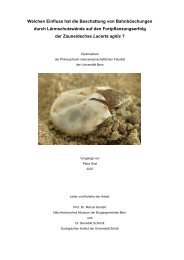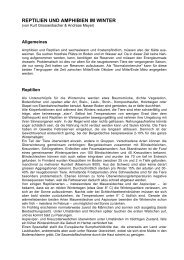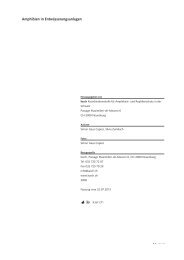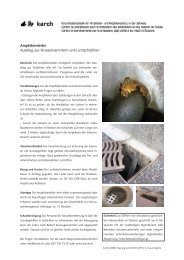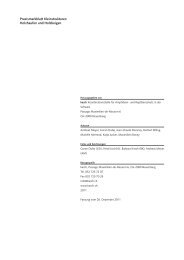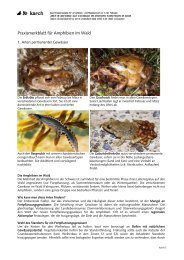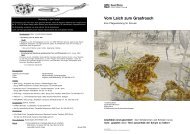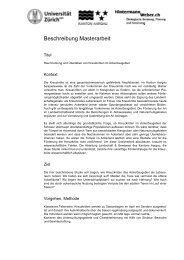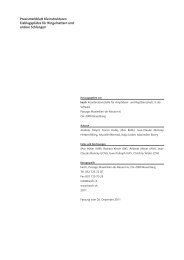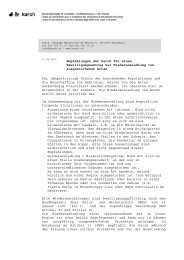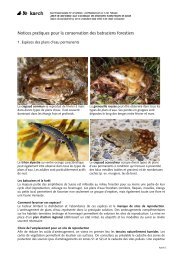Die Geburtshelferkröte (Alytes obstetricans) - Karch
Die Geburtshelferkröte (Alytes obstetricans) - Karch
Die Geburtshelferkröte (Alytes obstetricans) - Karch
Sie wollen auch ein ePaper? Erhöhen Sie die Reichweite Ihrer Titel.
YUMPU macht aus Druck-PDFs automatisch weboptimierte ePaper, die Google liebt.
MÁRQUEZ RAFAEL:<br />
From zoological oddity to model organism: communication in the midwife toads<br />
(<strong>Alytes</strong> <strong>obstetricans</strong> and <strong>Alytes</strong> cisternasii<br />
Midwife toads are a primitive group of anurans with a peculiar reproductive behavior.<br />
Mating is terrestrial and males exhibit obligate parental care, carrying the egg strings<br />
twined around their hindlegs for several weeks on land, until tadpoles are fully functional<br />
and the eggs are released in the water. In addition to its parental behavior, <strong>Alytes</strong> have<br />
a highly simplified vocal communication. Mating calls are short tonal calls - virtually pure<br />
tones - with no harmonic structure, and lacking elaborate amplitude modulation. Several<br />
populations of <strong>Alytes</strong> have been studied in continental Spain since 1987. Descriptive<br />
studies established that call duration and call dominant frequency were static<br />
characteristics and call interval was much more variable or (dynamic characteristic).<br />
Significant correlations were found between the static call characteristics and other<br />
variables: call duration was highly correlated with temperature, and call frequency was<br />
correlated with male size. The distributions of advertisement call duration and frequency<br />
overlapped between different populations of <strong>Alytes</strong>, even if they belonged to different<br />
species. However, the covariance between temperature and call duration varied<br />
significantly between populations of different taxonomic groups. Large male<br />
reproductive advantage was found in several populations of both species and in several<br />
seasons. This trend resulted primarily from the fact that larger males obtained more<br />
matings and hence carried larger egg masses from more females than smaller males.<br />
Two types of two-speaker phonotaxis tests showed that calls with lower frequencies<br />
(emitted by larger males) were more attractive to females than calls with high<br />
frequencies. In syntopic populations of the two species there was no sign of character<br />
displacement in the male calls, but female preference was different than in allopatric<br />
situations: female preference for low frequency calls (that could be emitted by males of<br />
the other species) disappeared in A. cisternasii, and female A. <strong>obstetricans</strong>, did not<br />
exhibit preference for calls with longer duration (that could be emitted by heterospecific<br />
males). Studies of acoustic interactions between males show that males typically<br />
increase their calling rate when exposed to acoustic stimuli representing a nearby<br />
competitor. The response is different if the competitor's call is high or low in frequency,<br />
and also if the competitor's calling rate is fast or slow. Call alternation between males is<br />
non-random, both species having similar phase angles. Although call overlap between<br />
two males affects negatively female preference, in natural events, call alternation does<br />
not decrease call overlap and therefore can't be explained as a method to maximize<br />
signal transmission. Female preference for (duetto) call leaders or followers is different<br />
between species, although it appears that preferences can be reversed at different<br />
temperatures.<br />
Many of the differences observed in acoustical competition between males can be<br />
related with the differences in mating season length between the two populations (A.<br />
cisternasii is generally explosive and A. <strong>obstetricans</strong> has a more prolonged breeding<br />
season), and with the differences in selective pressures that these two scenarios<br />
incorporate. The resulting picture of the mating systems is one in which male<br />
competition is strictly acoustical, and female choice is based in both dynamic and static<br />
call characteristics.<br />
14



